Kichler 310155SBK User manual
- Category
- Household fans
- Type
- User manual
This manual is also suitable for

Rana
TM
310155
Instruction Manual
UL Model #310155xxx
Includes Wall Control

1
1. SAFETY RULES (READ AND SAVE THESE INSTRUCTIONS)
1. To reduce the risk of electric shock, insure
electricity has been turned off at the circuit
breaker or fuse box before beginning.
2. All wiring must be in accordance with the
National Electrical Code and local electrical
codes. Electrical installation should be
performed by a qualied licensed electrician.
3. WARNING: To Reduce The Risk Of Fire Or
Electric Shock, Do Not Use This Fan With
Any Solid-State Speed Control Device. Only
use the remote control provided by ceiling fan
manufacturer.
4. WARNING: To reduce the risk of personal
injury, use only the two steel screws (and
lock washers) provided with the outlet box for
mounting to the outlet box. Most outlet boxes
commonly used for the support of lighting
xtures are not acceptable for fan support and
may need to be replaced, consult a qualied
electrician if in doubt.
5. The outlet box and support structure must
be securely mounted and capable of reliably
supporting a minimum of 50 pounds. Use only
CUL Listed outlet boxes marked “FOR FAN
SUPPORT”.
6. The fan must be mounted with a minimum of
7 feet clearance from the trailing edge of the
blades to the oor.
7. Do not operate reversing switch while fan
blades are in motion. Fan must be turned off
and blades stopped before reversing blade
direction.
8. Avoid placing objects in the path of the blades.
9. To avoid personal injury or damage to the fan
and other items, be cautious when working
around or cleaning the fan.
10. Do not use water or detergents when cleaning
the fan or fan blades. A dry dust cloth or lightly
dampened cloth will be suitable for most
cleaning.
11. After marking electrical connections, spliced
conductors should be turned upward and
pushed carefully up into outlet box. The wires
should be spread apart with the grounded
conductor and the equipment-grounding
conductor on one side of the outlet box.
12. Electrical diagrams are reference only. Light
Kits that are not packed with the fan must be
CUL Listed and marked suitable for use with
the model fan you are installing. Switches must
be CUL General Use Switches. Refer to the
Instructions packaged with the light kits and
switches for proper assembly.
13. Suitable for use in wet locations when installed
in a GFCI protected branch circuit.
14. Use only with light kits marked “Suitable for
use in wet locations”.
WARNING
TO REDUCE THE RISK OF FIRE,
ELECTRIC SHOCK OR PERSONAL INJURY,
MOUNT FAN TO OUTLET BOX MARKED
“ACCEPTABLE FOR FAN SUPPORT”
WARNING
TO REDUCE THE RISK OF PERSONAL
INJURY, DO NOT BEND THE BLADE
BRACKETS (ALSO REFERRED TO AS
FLANGES) DURING ASSEMBLY OR AFTER
INSTALLATION. DO NOT INSERT OBJECTS
IN THE PATH OF THE BLADES.
WARNING
CHANGES OR MODIFICATIONS TO THIS
UNIT NOT EXPRESSLY APPROVED BY THE
PARTY RESPONSIBLE FOR COMPLIANCE
COULD VOID THE USER’S AUTHORITY TO
OPERATE THE EQUIPMENT.
FCC ID: RGB-60RECIR. This device complies with part 15 of the FCC rules. Operation is subject to the following two conditions:
(1) this device may not cause harmful interference, and (2) this device must accept any interference received, including
interference that may cause undesired operation. Changes or modications not expressly approved by the party responsible for
compliance could void the user’s authority to operate the equipment.

2
60” Rana
™
2. TOOLS AND MATERIALS REQUIRED
• Phillips screw driver
• Blade screw driver
• 11mm wrench
• Step ladder
• Wire cutters
3. PACKAGE CONTENTS
Unpack your fan and check the contents.
You should have the following items:
a. Fan blade/blade arm assemblies (3)
b. Ceiling mounting bracket, Canopy
and Canopy bottom cover
c. Ball/downrod assembly
d. Coupling cover
e. Fan motor assembly
f. Light kit pan
g. Light kit tter assembly
h. Glass shade
i. Extra non-light cap (for fan without
light kit use)
j. Receiver
k. Wall transmitter
l. Parts bag contents:
1) Mounting hardware:
Star washers (2), wire nuts (3),
machine screws (2), washers (2),
wood screws (2)
2) Blade attachment hardware
screws (7)
3) Safety cable hardware:
wood screw, lock washer, at
washer
a.
b.
c.
d.
e.
f.
g.
h.
i.
j.
k.
l.

3
4. MOUNTING OPTIONS
If there isn’t an existing UL (cUL for Canadian
Installation) listed mounting box, then read the
following instructions. Disconnect the power by
removing fuses or turning off circuit breakers.
Secure the outlet box directly to the building structure.
Use appropriate fasteners and building materials. The
outlet box and its support must be able to fully support
the moving weight of the fan (at least 50 lbs). Do not
use plastic outlet boxes.
Figures 1, 2, and 3 are examples of different ways to
mount the outlet box.
NOTE: If you are installing the ceiling fan on a sloped
(vaulted) ceiling, you may need a longer downrod
to maintain proper clearance between the tip of the
blade and the ceiling. A minimum clearance of 12” is
suggested for optimal operation.
NOTE: Depending on the location you have selected
for installation, you may need to purchase and install
a “Joist Hanger” for the support of the outlet box.
Make sure the joist hanger you purchase has been
designed for use with ceiling fans. (Fig. 4)
Outlet box
Provide strong
support
Recessed
outlet box
Ceiling
mounting
plate
Outlet box
Outlet box
ANGLED CEILING
MAXIMUM 30
°
ANGLE
Fig. 4
Fig. 3
Fig. 2
Fig. 1

4
60” Rana
™
Mounting screws
(supplied with
electrical box)
Hook
Ceiling
mounting
bracket
UL Listed
outlet box
120V Wires
Washers
Canopy
Canopy cover
5. HANGING THE FAN
REMEMBER to turn off the power before you
begin.
To properly install your ceiling fan, follow the
steps below.
Step 1. Remove the decorative canopy bottom
cover from the canopy by turning the cover
counterclockwise. (Fig.5)
Step 2. Remove the ceiling mounting bracket
from the canopy by removing (and save) one of
the two screws. Loosen the remaining screw by
a half turn. (Fig.5)
Step 3. Pass the 120 volt supply wires from
the ceiling outlet box through the center of the
ceiling mounting bracket. (Fig. 6)
Step 4. Attach the ceiling mounting bracket to
the outlet box using the screws and washers
included with the outlet box. (Fig. 6)
Step 5. Remove and discard the three screws
securing the plastic stabilizer on the bottom of
motor housing. Remove and discard the plastic
stabilizer. (Fig. 7)
Step 6. Remove the hanger ball from the
downrod assembly by loosening the setscrew,
removing the cross pin and turning the ball off
the downrod. (Fig.8)
Fig. 7
Fig. 6
Fig. 5
Plastic Stabilizer
Screws
Cross pin
Hanger ball
Set screw
Downrod
Fig. 8

5
Registration slot
Check tab
Supply wires
& Safety cable
Hitch
pin
Set screw
Downrod
Set screw
Coupling
Retaining
clip
Hanger ball
Set screw
Downrod
Coupling
Canopy
Canopy cover
Coupling
cover
Cross pin
Supply wires
& Safety cable
Step 7. Loosen the two setscrews and remove the
hitch pin and retaining clip from the coupling on top
of the motor assembly. (Fig. 9)
Step 8. Carefully route the electrical supply
wires and safety cable exiting the top of the fan
motor assembly through the downrod. Thread the
downrod into the coupling until the hitch pin holes
are aligned. (Fig. 9)
Next, replace the hitch pin and retaining clip.
Tighten both setscrews. (Fig. 9)
Step 9. Slip the coupling cover, canopy cover and
canopy onto the downrod. (Fig. 10)
Thread the hanger ball onto the downrod, insert the
cross pin through the downrod and tighten. Now
tighten the set screw. (Fig. 10)
Step 10. Lift the motor assembly into position and
place the hanger ball into the ceiling mounting
bracket.
Rotate the entire assembly until the “Check Tab”
has dropped into the “Registration Slot” and seats
rmly. (Fig. 11)
The entire motor assembly should not rotate (left or
right) when seated properly.
WARNING: Failure to reattach the cross pin and
seat the “Check Tab” can cause the fan to fall from
the ceiling during operation. Take special care to
make sure this pin is reattached.
Fig. 10
Fig. 9
Fig. 11

6
60” Rana
™
Code switch
HI
MED
LOW
FAN OFF
1 2 3 4
1234
ON
6. INSTALLATION OF SAFETY SUPPORT
(Required for Canadian installation ONLY)
A safety support cable is provided to help prevent the
ceiling fan from falling, please install it as follows.
Step 1. Attach the provided wood screw and washers
to the ceiling joist next to the mounting bracket but do
not tighten. (Fig. 12)
Step 2. Adjust the length of the safety cable to reach
the screw and washers by pulling the extra cable
through the cable clamp until the overall length is
correct, put the end of the cable back through the
cable clamp, forming a loop at the end of the cable.
Tighten the cable clamp securely. Now, put the loop
in the end of the safety cable over the wood screw
securely.
NOTE: Although the safety support cable is required
for Canadian installations only. It’s a good idea to
make the attachment with any installation.
7. ELECTRICAL CONNECTIONS
WARNING: To avoid possible electrical shock, be
sure you have turned off the power at the main circuit
panel.
NOTE: The frequencies on your receiver and wall
transmitter have been preset at the factory. Before
installing the receiver, make sure the dip switches on
the receiver and wall transmitter are set to the same
frequency. (Fig. 13)
Step 1. Insert the receiver into the ceiling mounting
bracket with the at side of the receiver facing the
ceiling. (Fig. 14)
For best performance, make sure the Black antenna,
on the end of the receiver, remains extended and not
tangled with any of the electrical wires.
Step 2. Motor to Receiver Electrical connections:
Connect the black wire from the fan to the black wire
marked “TO MOTOR L” on the receiver. (Fig. 15)
Fig. 14
Fig. 13
Fig. 12
Receiver
Hanger
bracket
Hanger bracket
Safety cable
Attach safety cable
to ceiling joist with
screw and washer

7
White (neutral)
Green or bare
copper (ground)
White ("AC IN N")
Outlet box
Black (hot)
Black ("AC IN L")
Receiver
White (neutral)
White ("to motor N")
Ground
(green)
Black ("to motor L")
Blue (for light)
Blue (for light)
Black (motor)
Outlet box
Ceiling
mounting
bracket
Canopy
Canopy cover
Screw
Screw
(Connect to ground
wire on hanger
bracket if no house
ground wire exists.)
Connect the white wire from the fan to the white wire
marked ”TO MOTOR N” from the receiver. Connect the
blue wire from the fan to the blue wire marked ”FOR
LIGHT” from receiver. Secure all the wire connections with
the plastic wire nuts provided.
Step 3. Receiver to House Supply Wires Electrical
Connections: Connect the black (hot) wire from the ceiling
to the black wire marked “AC in L” from the receiver.
Connect the white (neutral) wire from the ceiling to the
white wire marked ”AC in N” from the Receiver. Secure
the wire connections with the plastic wire nuts provided.
(Fig. 15)
Step 4. If your outlet box has a ground wire (green or
bare copper) connect it to the fan ground wires; otherwise
connect the hanging bracket ground wire to the mounting
bracket. Secure the wire connection with a plastic nut
provided. After connecting the wires, spread them apart
so that the green and white wires are on one side of the
outlet box and black and blue wires are on the other side.
Carefully tuck the wire connections up into the outlet box.
(Fig. 15)
NOTE: Fan must be installed at a maximum distance
of 30 feet from the wall transmitter for optimal signal
transmission between the transmitter and the fan’s
receiver unit.
8. FINISHING THE INSTALLATION
Step 1. Tuck all the connections neatly into the ceiling
outlet box.
Step 2. Slide the canopy up to the mounting bracket and
place one of the key hole slots over the mounting screw
on the mounting bracket. Rotate the canopy until the
screw head locks in place at the narrow section of the key
hole. (Fig. 16)
Step 3. Align the remaining circular hole on the canopy
with the remaining hole on the Ceiling Mounting Bracket.
Insert and tighten the mounting screw from step 2 above.
Now, attach the canopy cover to the mounting screw head
by inserting the screw heads into the bottom side of the
canopy cover and rotating the cover clockwise.
NOTE: Adjust the canopy screws as necessary until the
canopy and canopy cover are snug. (Fig. 16)
Fig. 16
Fig. 15

8
60” Rana
™
9. ATTACHING THE FAN BLADE/
BLADE ARM ASSEMBLIES
Attach each blade assembly to the motor by using
two mounting screws for each blade assembly.
(Fig. 17)
NOTE: Make sure these mounting screws are
securely tightened.
10. INSTALLING THE LIGHT KIT PAN
Step 1. Remove one screw from the bracket below
fan motor assembly and loosen but do not remove
the other two screws. (Fig. 18)
Step 2. Push the light kit pan up to the fan motor
assembly so that the two loosened screw heads
t into the keyholes slots. Turn the light kit pan
clockwise. (Fig. 19)
Step 3. Re-install the screw that was removed in
step 1. (Fig. 19)
NOTE: Make sure these mounting screws are
securely tightened.
Screws
Light kit pan
Screws
Fig. 19
Fig. 18
Fig. 17
Screws
Blade arm
Blade

9
11. INSTALLING THE LIGHT KIT
FITTER ASSEMBLY
Step 1. Remove one screw from the light kit pan, and
loosen, but do not remove the other two screws. (Fig. 20)
Step 2. Connect the blue wire exiting the bottom of fan
motor assembly with the black wire from the top of the
light kit tter assembly. (Fig. 20)
Step 3. Connect the white wire exiting the bottom of fan
motor assembly with the white wire from the top of the
light kit tter assembly. (Fig. 20)
Step 4. Push the light kit tter assembly up to the light
kit pan so that the two loosened screw heads t into the
keyholes slots. Turn the light kit tter assembly clockwise
to secure. (Fig. 20)
Step 5. Re-install the screw that was removed in step 1.
(Fig. 20)
NOTE: Make sure the mounting screws are securely
tightened.
12. INSTALLING THE SHADE
Place the glass shade into the light kit pan, aligning the
three at areas on the top ange of the shade with the
three raised dimples in the light kit pan. Turn the shade
clockwise until it stops. (Fig. 21)
NOTE: Do not overtighten when installing the shade into
the light kit. Allow the shade to cool completely before
removing.
If you install your fan without the light kit, do not install the
light kit tter assembly and follow step below.
Place the non-light cap into the light kit pan, aligning the
three at areas on the top ange of the non-light cap with
the three raised dimples in the light kit pan. Turn the non-
light shade clockwise until it stops. (Fig.22)
Light kit
fitter assembly
screw
Glass shade
Non-light cap
Fig. 22
Fig. 21
Fig. 20

10
60” Rana
™
13. INSTALLING THE BATTERIES
Remove the face plate of the Wall Switch by
lifting at the top and then inserting the supplied
12V battery. Duracell MN21/Eveready A23/ GP
23A all 12V.
Replace the switch face plate.
To prevent possible damage to the transmitter,
remove these batteries if not used for long
periods of time (months).
14. OPERATING INSTRUCTIONS
HI Button = High Speed
MED Button = Medium Speed
LOW Button = Low Speed
FAN OFF Button = Motor Off
LIGHT Button = Light ON or OFF
REV Button = The “REV” button is
used to set the fan
forward or reverse,
press the button
forward (for warm
weather) or reverse
(for cool weather).
Speed settings for warm or cool weather depend
on factors such as the room size, ceiling height,
number of fans and so on.
NOTE: To operate the reverse function on this
fan, press the reverse button while the fan is
running.
HI
MED
LOW
FAN OFF
ON ECE
1234
23AE 12V
Fig. 24
Fig. 23

11
15. INSTALLING THE BASIC FUNCTION
WALL CONTROL SYSTEM WALL
PLATE
Select a location to install the Basic Function Wall
Control System Transmitter and Wall Plate.
REMEMBER you can safely use the transmitter
outdoors but it should be mounted indoors away
from contact with water or humidity.
Install the wall plate using an existing wall switch
outlet box. Make sure the electrical power is
TURNED OFF at the main panel before continuing.
Step 1. Remove the existing wall plate and the
old switch from the wall outlet box. Wire nut the
BLACK leads (hot) together and push back inside
the outlet box. (Fig. 25)
Step 2. Install the wall plate on the existing wall
outlet box using the screws provided. (Fig. 26)
After installing the wall anchors, attach the wall
plate with the mounting screws to nish the
installation.
Wall plate
Switch
Outlet box
Screws
Outlet box
Screws
Wall plate
Switch
Fig. 26
Fig. 25

12
60” Rana
™
16. OPERATING INSTRUCTIONS
The Black Slide Switch on the side of the switch
housing controls the direction of the blades
“Forward and Reverse”.
Warm weather - Forward (counter clockwise).
A downward airow creates a cooling effect as
shown in Fig. 27. This allows you to set your air
conditioner to warm setting without affecting your
comfort.
Cool weather - Reverse (clockwise).
An upward airow moves warm air off the ceiling
area as shown in Fig. 28. This allows you to
set your heating unit on a cooler setting without
affecting your comfort.
NOTE: To change the direction of rotation for the
fan blades, locate the reverse switch located on
the top of the motor housing.
Fig. 28
Fig. 27

13
17. TROUBLESHOOTING
Problem
Fan will not start.
Fan sounds noisy.
Fan wobbles.
Remote control
malfunction.
Solution
1. Check circuit fuses or breakers.
2. Check all electrical connections to insure proper contact. CAUTION: Make sure the
main power is OFF when checking any electrical connection.
3. Make sure the transmitter batteries are installed properly. Positive (+) side facing out.
4. Insure the batteries have a good charge.
1. Make sure all motor housing screws are snug.
2. Make sure the screws that attach the fan blade brackets to the motor are tight.
3. Make sure wire nut connections are not rubbing against each other or the interior wall
of the switch housing. CAUTION: Make sure main power is off.
4. Allow a 24-hour “breaking-in period. Most noise associated with a new fan disappears
during this time.
5. If using an optional light kit, make sure the screws securing the glassware are tight.
Make sure the light bulbs are not touching any other component.
6. Do not connect this fan to wall mounted variable speed control(s). They are not
compatible with ceiling fan motors or remote controls.
7. Make sure the upper canopy is a short distance from the ceiling. It should not touch
the ceiling.
1. Check that all blade and blade arm screws are secure.
2. Most fan wobbling problems are caused when blade levels are unequal. Check this
level by selecting a point on the ceiling above the tip of one of the blades. Measure
this distance. Rotate the fan until the next blade is positioned for measurement.
Repeat for each blade. The distance deviation should be equal within 1/8”.
3. Use the enclosed Blade Balancing Kit if the blade wobble is still noticeable.
4. If the blade wobble is still noticeable, interchanging two adjacent (side by side) blades
can redistribute the weight and possibly result in smoother operation.
1. Ceiling fans with remote control systems CAN NOT be operated in conjunction with
any other control system EXCEPT a basic On/Off wall switch, if desired.
2. Make sure the frequency dip switches in the transmitter and receiver have identical
settings.
3. Make sure the Black Antenna on the receiver is NOT tangled with any other electrical
wires and is extended around the inside of the ceiling canopy.
18. SPECIFICATIONS
Fan size Speed Volts Amps Watts RPM CFM CFM/W N.W. G.W. C.F.
60”
High
120
0.59 70.5 200 9006 128
11.4
kgs
13.0
kgs
2.43’Medium 0.42 36.5 135 6293 173
Low 0.28 16.0 80 3948 246
These are approximate measurements. They do not include data for any lamps or xtures attached to the ceiling fan.

Kichler
®
Lighting
7711 East Pleasant Valley Road
P.O. Box 318010
Cleveland, Ohio 44131-8010
Customer Service
866.558.5706
8:30 AM to 5:00 PM EST,
Monday - Friday
Page is loading ...
Page is loading ...
Page is loading ...
Page is loading ...
Page is loading ...
Page is loading ...
Page is loading ...
Page is loading ...
Page is loading ...
Page is loading ...
Page is loading ...
Page is loading ...
Page is loading ...
Page is loading ...

Kichler
®
Lighting
7711 East Pleasant Valley Road
P.O. Box 318010
Cleveland, Ohio 44131-8010
Service à la clientèle
866 558-5706
entre 8h30 et 17h, HNE,
du lundi au vendredi
-
 1
1
-
 2
2
-
 3
3
-
 4
4
-
 5
5
-
 6
6
-
 7
7
-
 8
8
-
 9
9
-
 10
10
-
 11
11
-
 12
12
-
 13
13
-
 14
14
-
 15
15
-
 16
16
-
 17
17
-
 18
18
-
 19
19
-
 20
20
-
 21
21
-
 22
22
-
 23
23
-
 24
24
-
 25
25
-
 26
26
-
 27
27
-
 28
28
-
 29
29
-
 30
30
Kichler 310155SBK User manual
- Category
- Household fans
- Type
- User manual
- This manual is also suitable for
Ask a question and I''ll find the answer in the document
Finding information in a document is now easier with AI
in other languages
- français: Kichler 310155SBK Manuel utilisateur
Related papers
-
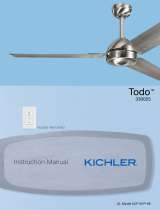 Kichler Lighting 330025SBK User manual
Kichler Lighting 330025SBK User manual
-
Kichler Lighting 330243NI User manual
-
Kichler 300317DBK User manual
-
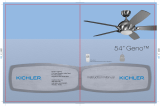 Kichler Lighting 330001BSS User manual
Kichler Lighting 330001BSS User manual
-
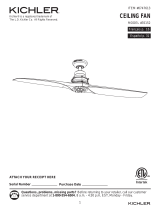 Kichler Lighting 35152 User manual
Kichler Lighting 35152 User manual
-
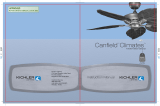 Kichler Lighting 320500CMO User manual
Kichler Lighting 320500CMO User manual
-
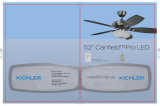 Kichler Lighting 330013NI User manual
Kichler Lighting 330013NI User manual
-
Kichler 35153A Installation guide
-
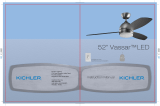 Kichler Lighting 330002WH User manual
Kichler Lighting 330002WH User manual
-
Kichler 330130 Installation guide
Other documents
-
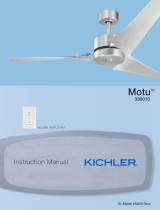 Kichler Lighting 330010NI User manual
Kichler Lighting 330010NI User manual
-
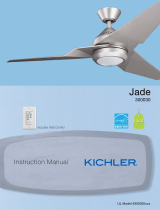 Kichler Lighting 300030AP User manual
Kichler Lighting 300030AP User manual
-
Progress Lighting 93099659 B Installation guide
-
Halcyon EX800 9W Exterior Surface Mount Spot Installation guide
-
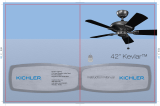 Kichler Lighting 310144MWH User manual
Kichler Lighting 310144MWH User manual
-
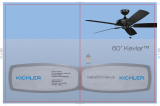 Kichler Lighting 310150MWH User manual
Kichler Lighting 310150MWH User manual
-
Progress Lighting 93099650 B Installation guide
-
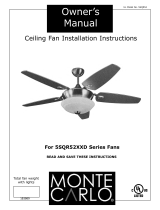 Monte Carlo Fan Company 5HNR52 Owner's manual
Monte Carlo Fan Company 5HNR52 Owner's manual
-
for Living 3-Reversible Blade 3-Speed Owner's manual
-
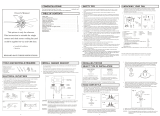 Yosemite Home Decor WESTFIELD-ORB-4 Installation guide
Yosemite Home Decor WESTFIELD-ORB-4 Installation guide









































